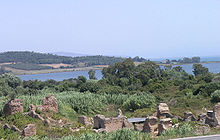Nicopolis (Epirus)
Nikopolis ( Greek Νικόπολις ( f. Sg. ), In Latin form also Nicopolis ; from Greek νίκη "victory" and πόλις "city", ie "city of victory") is the name of an ancient Roman city in northwestern Greece in the Epirus region on the Ambracian Golf near Préveza . The city was abandoned around the 12th century. In their place was the nearby Preveza .
The city was founded in 31 BC. Founded by Octavian, the later emperor Augustus , after this on September 2, 31 BC. BC the fleet of Mark Antony and Cleopatra VII had fought in the sea battle at Actium . The battle was part of the power struggle between Octavian and Antonius after the death of Julius Caesar .
In order to get residents for the new city, nearby villages such as B. Cassope amalgamated with Nicopolis by Synoikismos . Due to political and financial privileges and its favorable location, the city grew rapidly and became an important trading hub. At its heyday, 320,000 people are said to have lived in Nicopolis.
The city was geographically favorable because the Ambracian Gulf is separated from the Ionian Sea ( Mediterranean Sea ) by the Préveza peninsula . On the side of the peninsula facing away from the Mediterranean is the Mazoma lagoon, which was ideal as a natural, protected harbor. Whether this bay already had a connection to the sea before the city was built is controversial among researchers.
Octavian also decreed that the festival called Actia should take place at the Apollo shrine to the south . These were roughly comparable to the Olympic Games , but also extended to musical competitions.
Nicopolis was one of the early Christian cities . It was visited by the Apostle Paul on his trip to Rome as early as 62–63 AD . During excavations, six basilicas were found, which presumably date from the 4th century.
In 293 AD Nicopolis became the capital of Epirus. At the beginning of the 5th century it was captured, plundered and partially destroyed by the Goths. Emperor Justinian I rebuilt it in 540 AD with stronger walls and 35 towers.
In 1032 Nicopolis was destroyed by the Bulgarians who sealed the end of the city. It was partially rebuilt, but no longer reached its old dimensions. The center moved to Préveza.
In 1913 excavations began in this area, which lasted in several stages until 1975.
literature
- Jacob Isager (Ed.): Foundation and Destruction. Nikopolis and Northwestern Greece. The archaeological evidence for the city destructions, the foundation of Nikopolis and the synoecism (Monographs of the Danish Institute at Athens, 3). University Press, Aarhus 2001, ISBN 87-7288-734-6 .
- William M. Murray, Photios M. Petsas: Octavian's campsite memorial for the Actian war (Transactions of the American Philosophical Society, NS 79,4). American Philosophical Society, Philadelphia 1989, ISBN 0-87169-794-7 .
- Konstantinos L. Zachos, Evangelos A. Pavlidis: Nikopolis, the city of victory near Actium. The research results of the last few years. In: Heide Frielinghaus , Jutta Stroszeck (ed.): New research on Greek cities and sanctuaries. Festschrift for Burkhardt Wesenberg on his 65th birthday (= contributions to the archeology of Greece. Volume 1). Bibliopolis, Möhnesee 2010, ISBN 978-3-933925-91-6 , pp. 139-160.
Web links
Coordinates: 39 ° 0 ′ 30 ″ N , 20 ° 44 ′ 1 ″ E

